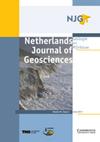荷兰莱茵-默兹三角洲地下构造对冲刷孔形成的影响
IF 2.3
2区 地球科学
Q3 GEOSCIENCES, MULTIDISCIPLINARY
Netherlands Journal of Geosciences-Geologie En Mijnbouw
Pub Date : 2023-03-23
DOI:10.1017/njg.2023.5
引用次数: 0
摘要
冲刷孔是三角洲河流的共同特征,它可以通过河床的过度陡变而破坏河堤的稳定。它们的发展已经从水力角度进行了广泛的研究,但另一个重要的控制因素是河床的可蚀性,由于非均质三角洲基底向海岸加厚,河床的可蚀性变化很大。因此,除了水动力控制外,我们还评估了三角洲尺度的地质非均质性和局部地下结构对冲刷孔形成的影响。我们(1)创建了莱茵-默兹三角洲165个冲刷孔位置的清单,(2)评估了这些位置的水动力条件,(3)提取了几何特征,(4)根据地质数据确定了地下结构。三角洲中部和下游分支每公里冲刷量为0.6-0.7次,而三角洲上游分支每公里冲刷量小于0.2次。下游58%的冲刷孔与建筑元素有关,主要为前全新世河道带砂体和早全新世黏结层砂体。由于河床附近黏性沉积物的比例较高,这些冲刷具有更陡峭的斜坡。此外,与河道带砂体相关的冲刷在下游长度和深度上是有限的,最大可达水深的两倍左右。根据我们的研究结果,我们提供了一个三角洲尺度的解释框架,将现代河道的位置与更新世河流沉积物和全新世河流三角洲沉积物联系起来,以形成冲刷孔。上游河流是在更新世沉积物中切割的,可蚀性的局部变化较小。这里的冲刷孔大多与工程有关。在三角洲中部和下游分支,在靠近河道底部的临界深度处,全新世底物的地质遗传非均质性增加了人为冲刷并导致高丰度。这表明,地下结构的下游变化应被视为对冲刷位置和特征进行管理的关键控制。本文章由计算机程序翻译,如有差异,请以英文原文为准。
The influence of subsurface architecture on scour hole formation in the Rhine–Meuse delta, the Netherlands
Abstract Scour holes are common features in deltaic rivers which can destabilise embankments through oversteepening of the river bed. Their development has been studied extensively from the hydraulic perspective, but another important control is the erodibility of the river bed which varies considerably due to thickening of heterogeneous deltaic substrate towards the coast. Therefore, we assessed the influence of delta-scale geological heterogeneity and local subsurface architecture on scour hole formation in addition to the hydrodynamic controls. We (1) created an inventory of 165 scour hole locations in the Rhine–Meuse delta, (2) assessed the hydrodynamic conditions at the locations, (3) extracted geometric characteristics and (4) determined the subsurface architecture from geological data. Central and lower delta branches have 0.6–0.7 scours per km while upper delta branches have less than 0.2. Downstream, 58% of scour holes were related to architectural elements, notably sand bodies from former Holocene channel belts and Early Holocene cohesive beds. These scours have steeper slopes due to higher proportions of cohesive sediments near the river bed. Furthermore, scours related to channel belt sand bodies are limited in downstream length and depth, up to maximum of approximately two times the water depth. From our results, we provide a delta-scale explanatory framework that relates the position of present-day river channels with respect to Pleistocene river deposits and Holocene fluvio-deltaic deposits to scour hole formation. Upstream rivers are incised in Pleistocene deposits showing less local variation in erodibility. The majority of scour holes here relate to engineering works. In central and lower delta branches, geologically inherited heterogeneity of the Holocene substrate at critical depths near the channel bottom adds to anthropogenic induced scours and results in high abundances. This demonstrates that downstream variation in subsurface architecture should be considered as a key control on scour locations and characteristics for management purposes.
求助全文
通过发布文献求助,成功后即可免费获取论文全文。
去求助
来源期刊
CiteScore
4.00
自引率
25.90%
发文量
14
审稿时长
>12 weeks
期刊介绍:
Netherlands Journal of Geosciences - Geologie en Mijnbouw is a fully open access journal which publishes papers on all aspects of geoscience, providing they are of international interest and quality. As the official publication of the ''Netherlands Journal of Geosciences'' Foundation the journal publishes new and significant research in geosciences with a regional focus on the Netherlands, the North Sea region and relevant adjacent areas. A wide range of topics within the geosciences are covered in the journal, including "geology, physical geography, geophyics, (geo-)archeology, paleontology, hydro(geo)logy, hydrocarbon exploration, modelling and visualisation."
The journal is a continuation of Geologie and Mijnbouw (published by the Royal Geological and Mining Society of the Netherlands, KNGMG) and Mededelingen Nederlands Instituut voor Toegepaste Geowetenschappen (published by TNO Geological Survey of the Netherlands). The journal is published in full colour.

 求助内容:
求助内容: 应助结果提醒方式:
应助结果提醒方式:


